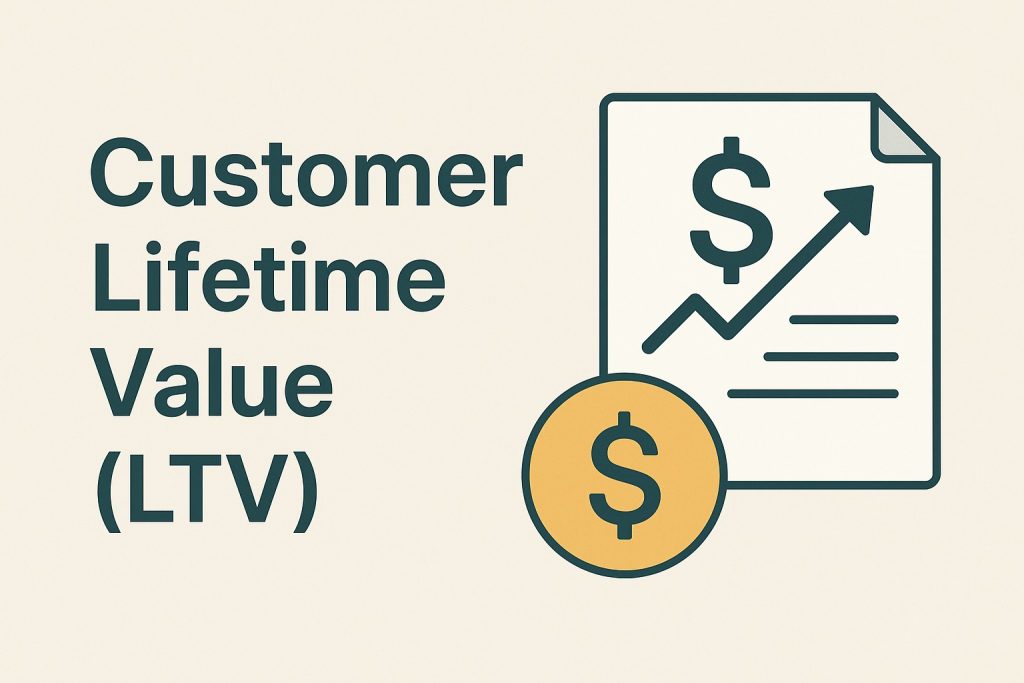Stop focusing only on that first sale.
Seriously. While acquiring new customers feels great, the real gold is in the customers you already have. If you’re chasing new leads but ignoring your existing customer base, you’re leaving a massive pile of cash on the table.
What if I told you there’s a metric that can shift your entire marketing focus and unlock explosive business growth? It’s called Customer Lifetime Value (LTV). Understanding and improving your LTV is one of the most powerful things you can do for your business.
This guide will break down exactly what LTV is, why it’s a game-changer, and how you can calculate and boost it. Let’s dive in.
What is Customer Lifetime Value (LTV)?
Customer Lifetime Value (LTV or CLV) is the total revenue a business can reasonably expect from a single customer account throughout their entire relationship. It’s a forecast of the net profit attributed to the whole future relationship with a customer.

Think of it this way: instead of just looking at a customer’s first purchase of $50, LTV looks at all their potential future purchases. Maybe that same customer will spend $50 every month for the next three years. Their LTV isn’t $50; it’s actually $1,800. See the difference?
This metric forces you to think long-term. It helps you understand the true worth of your customers and guides your decisions on marketing spend, customer service, and product development.
Why LTV is a Metric You Can’t Ignore
Focusing on LTV transforms your business strategy from a short-term scramble for sales into a long-term plan for sustainable growth. It puts the customer relationship at the center of everything.
Here’s why it’s so critical:
- Maximizes Profitability: It costs 5 to 25 times more to acquire a new customer than to retain an existing one. By focusing on increasing the value of your current customers, you dramatically improve your profit margins.
- Informs Your Marketing Spend: Knowing your LTV helps you determine your Customer Acquisition Cost (CAC). If the average LTV is $1,000, you know you can spend more than if your LTV is only $100. A healthy business model requires your LTV to be significantly higher than your CAC, typically by a ratio of 3:1.
- Improves Customer Retention: When you start tracking LTV, you naturally start focusing on keeping customers happy. This leads to better customer retention strategies, which are the backbone of a successful business.
- Identifies Your Best Customers: LTV helps you segment your audience and identify your high-value customers. You can then tailor marketing campaigns to these VIPs, encouraging loyalty and even more spending.
How to Calculate Customer Lifetime Value (The Simple Way)
Calculating LTV can seem complex, with various formulas floating around. Let’s stick to a straightforward and effective method that works for most businesses.
You need three key pieces of data first:
- Average Purchase Value (APV): Total revenue in a period / Number of purchases in that period.
- Average Purchase Frequency Rate (APFR): Number of purchases / Number of unique customers.
- Customer Lifetime: The average length of time a customer continues to buy from you.
Once you have those, the LTV calculation is simple.
First, calculate your Customer Value:
Customer Value = Average Purchase Value x Average Purchase Frequency RateThis tells you how much a customer is worth in a specific period (like a year).
Next, to find the lifetime value, you multiply that by their lifespan:
LTV = Customer Value x Average Customer Lifetime
LTV Calculation Example:
Let’s imagine you run an online coffee subscription box.
- Average Purchase Value: $40 (the price of one box)
- Average Purchase Frequency: 12 (they order once a month)
- Average Customer Lifetime: 2 years
Let’s calculate:
- Customer Value = $40 x 12 = $480 per year.
- LTV = $480 x 2 = $960.
The lifetime value of your average coffee subscriber is $960. Now you know you can afford to spend up to a third of that ($320) to acquire a similar customer and still maintain a healthy business.
5 Actionable Strategies to Boost Your LTV
Calculating LTV is just the first step. The real magic happens when you actively work to increase it. Boosting LTV means getting customers to buy more often, spend more money, and stay with you for longer.
Here are five proven customer retention strategies to boost LTV.
1. Master the Art of Onboarding
A customer’s first experience with your product or service sets the tone for the entire relationship. A confusing or frustrating onboarding process is a recipe for churn.
Create a smooth, helpful, and engaging onboarding experience.
- Welcome Emails: Send a series of welcome emails that guide users, highlight key features, and show them how to get value quickly.
- In-App Guides: Use tooltips and interactive walkthroughs to teach users how to use your software.
- Personalized Support: Offer a quick setup call or a personal check-in to make new customers feel valued.
2. Implement a Killer Loyalty Program
Loyalty programs are a direct way to encourage repeat purchases to increase more royal customers. They reward customers for sticking with you, making it less likely they’ll switch to a competitor.
- Points System: Customers earn points for every purchase, which can be redeemed for discounts or free products.
- Tiered Rewards: Create tiers (e.g., Silver, Gold, Platinum) that unlock better perks as customers spend more. This gamifies the experience and encourages higher spending.
- Exclusive Access: Offer loyal customers early access to new products, special sales, or exclusive content.
3. Leverage Upselling and Cross-Selling
One of the easiest ways to increase your Average Purchase Value is to sell more to your existing customers.
- Upselling: Encourage customers to purchase a more expensive version of a product (e.g., a “pro” version with more features).
- Cross-selling: Suggest related or complementary products. If someone buys a camera, offer them a memory card and a tripod at checkout.
Amazon is the master of this. Its “Frequently Bought Together” and “Customers who bought this also bought” sections are perfect examples of effective cross-selling.
4. Provide World-Class Customer Service
Exceptional customer service turns happy customers into lifelong advocates. When problems arise, a swift and helpful response can strengthen a customer’s loyalty more than if nothing had gone wrong at all.
- Be Accessible: Offer support through multiple channels (email, chat, phone) and respond quickly.
- Empower Your Team: Give your support team the authority to solve problems without escalating every issue.
e* Go the Extra Mile: A small, unexpected gesture, like a handwritten thank you note or a small discount after a resolved issue, can make a huge impact.
5. Use Email Marketing to Stay Connected
Don’t let your customers forget about you. Consistent, valuable communication keeps your brand top-of-mind and provides opportunities for repeat sales by doing email marketing for your business.
- Segmentation is Key: Don’t send the same email to everyone. Segment your list based on purchase history, browsing behavior, or engagement level.
- Provide Value: Send more than just promotional offers. Share helpful tips, industry news, or entertaining content related to your products.
- Re-engagement Campaigns: Target customers who haven’t purchased in a while with a special offer to win them back.
Conclusion: Make LTV Your North Star Metric
Customer Lifetime Value isn’t just another vanity metric. It’s a practical, powerful tool that can fundamentally change the way you run your business. By shifting your focus from short-term acquisition to long-term value, you build a more resilient, profitable, and customer-centric company.
Start by calculating your LTV today. It doesn’t have to be perfect, just a baseline. Then, choose one or two of the strategies above and start implementing them.
Track your progress, see what works, and keep refining your approach.
When you make boosting LTV a priority, you’re not just improving a number on a spreadsheet, you’re building better, stronger, and more valuable relationships with the people who matter most: your customers.


